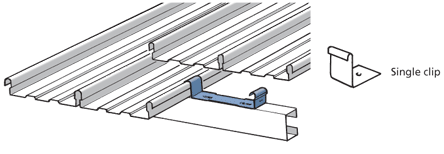Self-Supporting Cladding
Self-supporting cladding is roll-formed with different means of interlocking the adjacent panels. It can be :
- spring snapped together;
- rotated through 180°; or
- machine closed in situ.
Where the required lengths are too long to be easily transported, and the contract warrants it, the roll forming can be done on-site to avoid damage and reduce packaging and transport costs.
Because there are no external fixings, the wind uplift load on the cladding is resisted by:
- the strength of the profile;
- the clip;
- the screws, nails or rivets, and
- the substrate.
The loads imposed on the cladding are described in section 3.4.
In many cases, the uplift load that can be resisted by these component parts or the re-entrant cladding design is not as great as that for pierced fixed cladding. Designers should be aware of these limitations in high and very high wind design load areas.
The weakest parts of the clipping system are usually the clips or the clip fixing to the substrate, as the clips are secured by using screws, nails or rivets.
Each clip must enable free movement for expansion within the clipping system. Each clip must have a minimum of two fixings, and the pull-out or withdrawal load of each fixing must exceed half that of the wind design load.
The fixings must be suitable for the substrate.
For timber the fixings should be:
- nails with an enhanced shank of 50 mm long; or
- 10# x 25mm wafer head screws.
For steel the fixings should be:
- 10# x 16mm wafer head screws; or
- 12# hex head screws (where profile provides clearance).
Secret fix clips must not bind the cladding, as this will erode the metal and produce excessive noise. Clips must be fixed at centres determined by the panel width and the wind design load. Additional clips must be used to provide resistance to the high wind load in the peripheral areas of the roof.
Self-supporting secret fixed claddings can be curved over a radius, but as they are asymmetrical profiles, the radii should be shallow to avoid purlin creasing and panning.
Unless expansion provisions are made to positively fix elsewhere, secret-fix sheeting should be fixed at the highest point to avoid creep on steep roof slopes or due to the action of snow.
- Log in to post comments

